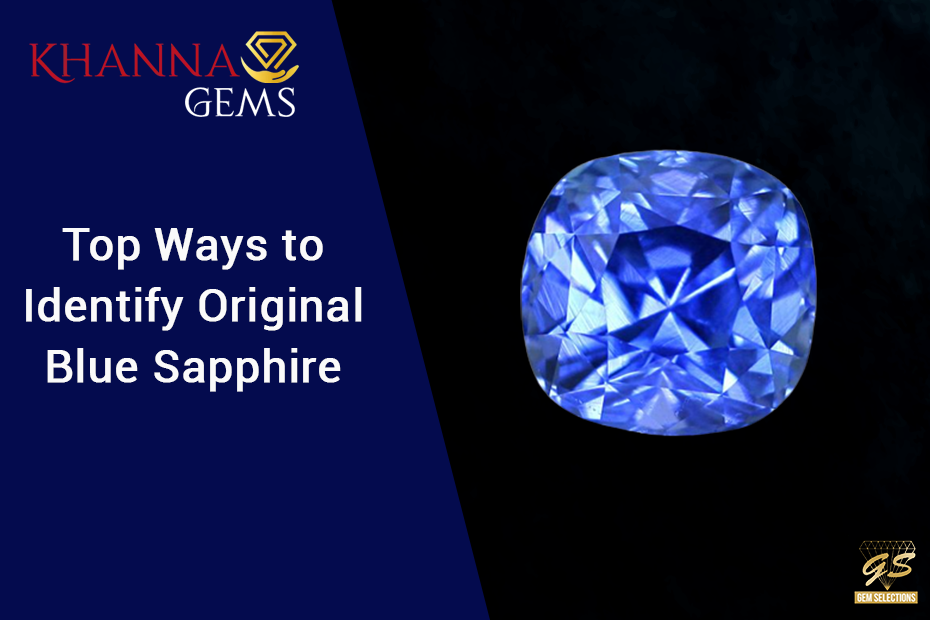Blue sapphire stone price in India is highly valued, and we know it for its stunning blue colour and its association with good luck and protection. However, because of its ubiquity and high price, it is frequently targeted by dishonest traders who market fake or synthetic stones as real blue sapphires. Understanding how to tell a genuine blue sapphire from a fake is crucial if you want to make sure you are buying an original stone.
Know The Characteristics of Blue Sapphire
Knowing the features of blue sapphire is the first step in determining whether it is genuine. The same mineral that creates rubies, corundum, is the source of blue sapphire. One of the most durable gemstones, it rates a 9 on the Mohs scale for hardness. Genuine blue sapphire typically comes in a variety of blue hues, from light to deep. The iron and titanium in the crystal lattice are what gives the material its colour. The stone’s worth rises with colour consistency and intensity. Genuine blue sapphire also reflects light brilliantly due to its high refractive index, which gives it a beautiful shine. It also has a smooth surface, and its facets ought to be symmetrical and clearly defined. Fake or synthetic blue sapphires, on the other hand, could be less durable, have a lower refractive index, and have a less even dispersion of colour. Blue sapphire’s clarity can also differ, with some stones having obvious imperfections and others appearing to be practically flawless. Natural blue sapphires frequently have inclusions, whereas synthetic or imitation stones may have fewer or none at all.
Check The Clarity
The absence or presence of imperfections or defects is referred to as the clarity of blue sapphire. Small flaws or intrinsic qualities that might lower a gemstone’s clarity and overall worth are known as inclusions. There will be some inclusions in a genuine blue sapphire, but they shouldn’t be too obvious to the unaided eye. Under a jeweller’s loupe, most blue sapphires will have some visible imperfections, but if the stone has too many or is clearly cracked, it might not be a genuine stone. A jeweller’s loupe or a microscope can be used to closely inspect the stone in order to determine the clarity of blue sapphire. Genuine blue sapphires frequently have inclusions, which are inherent flaws created during the process of production on the ground. Small crystals, needles, and colour zoning are a few examples of these inclusions. The clarity and price of the stone can be impacted by the quantity, size, and placement of the inclusions.
Check The Cut
The angles and dimensions of blue sapphire are referred to as the stone’s cut. A well-cut blue sapphire will have perfect symmetry and uniform light reflection across all of its facets. The overall value of the stone will be influenced by the cut as well. While a well-cut stone will have tremendous brightness and brilliance, a badly cut stone may appear lifeless and boring.
Check The Origin
You can evaluate the genuineness of the blue sapphire by looking at where it came from. The most expensive blue sapphires are found in Kashmir, but they are extremely uncommon and hard to come by. Additionally, significant sources come from Madagascar, Sri Lanka, and Burma. Analyzing the stone’s chemical composition and physical characteristics, such as its trace components and crystal structure, can also reveal its origin. By examining a blue sapphire’s chemical and physical features, advanced testing techniques like spectroscopy and chemical analysis can assist in identifying its place of origin. These techniques, nevertheless, typically only apply to gemmologists and call for specialized tools.
Check The Weight
Another sign of the genuineness of blue sapphire is its weight. Because they are formed of different materials, synthetic blue sapphires are frequently lighter than natural stones. Consequently, a genuine blue sapphire ought to feel substantial in your palm. Although a blue sapphire’s weight can be a good sign of validity, it cannot always be used to assess the stone’s legitimacy. The weight of blue sapphire can also be influenced by additional elements like size, cut, and imperfections. Weight alone should not be used to identify the authenticity of a blue sapphire because synthetic blue sapphires might weigh similarly to natural blue sapphires. To correctly recognize a genuine blue sapphire, it’s crucial to combine various elements, including those listed above. Treatments like heat treatment, which is frequently performed to improve the colour of blue sapphires, can also have an impact on a stone’s weight. Weight alone should not be used to determine the authenticity of a blue sapphire because heat-treated stones can be lighter than untreated ones due to the elimination of impurities.
Use a Gemmological Tester
Using a gemmological tester is one of the best ways to recognize a genuine blue sapphire. These testers employ a variety of techniques to determine the stone’s chemical and physical characteristics, such as its refractive index, specific gravity, and fluorescence. You can use these tests to identify whether the stone is artificial or real. A refractometer, which calculates a gemstone’s refractive index, is a frequently employed gemmological tester. Each type of gemstone has a different refractive index, which measures the speed of light through a material. A gemmologist can tell whether or not a blue sapphire is real by comparing its refractive index to values for natural sapphires.
Seek a Professional Opinion
Finally, it is always a good idea to get the advice of a qualified gemmologist or jewellery if you are still unsure about the genuineness of your blue sapphire. They will have the skills and knowledge necessary to evaluate the stone and give you their professional judgment. In conclusion, there are several sources where you can buy blue sapphire online, but it requires a combination of knowledge and experience. You may make sure you’re buying an actual blue sapphire by being aware of the features of the stone, looking at its clarity, cut, provenance, and weight, utilizing a gemmological tester, and getting a professional opinion.
